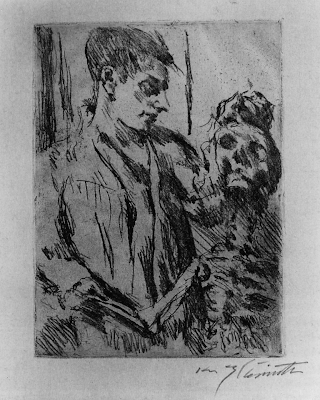Σάββατο 28 Ιουλίου 2012
William Basso
William Basso is a contamporary artist. Combining equal amounts of horror movie magazines and comic books with Renaissance or Eastern European art, for example, helped to shape Bill's artistic sensibilities. He talks about his work in his bio:
My work is a combination of various artistic disciplines including drawing, sculpture, photography, collage and painting. Used together, these allow me to create images of mystery, wonder, delight, sorrow and fear, which often take place in intimate stage-like settings.
The characters in my work exist in a distant, half-remembered, autumnal place where even Halloween can last forever. Images emerge through a cross-referencing of many artistic influences, memories and ideas. Ancient and flickering, monochrome films of the fantastic and macabre play continuously, running through rusted projectors. Long, silent corridors are hung with varnished, cracked paintings and brittle prints from another age, while rows of tall, wooden cabinets display bones and other arcane specimens behind panes of misted glass.
Although my work is photographically based, I would classify it as a form of mixed-media. I typically begin a piece by drawing and working out ideas on paper. This is followed by sculpting and constructing a series of miniature, doll-like characters or maquettes, as well as a variety of intricate handmade objects that are then photographed. These objects and constructions are made from all kinds of things like clay, cardboard, string, paper, wire, tape, wood, hair and odd bits of cloth. The photographs are processed in the computer.
As I'm working, it can feel as though I'm staging a tiny theater piece or perhaps curating a mysterious museum exhibit combined with a long ago forgotten sideshow of curiosities.
VISIT HIS SITE for more of his works
Δευτέρα 23 Ιουλίου 2012
Lovis Corinth, Totentanz
Lovis Corinth (1858 – 1925) was a German painter and printmaker whose mature work realized a synthesis of impressionism and expressionism.
It's a kind of mememto mori but without the mystification and dark and dramatic appearance of Death as alive and active figure as it happens in many memento mori paintings. The skeleton here is a suspended lifeless object of anatomy lessons and the whole picture with the vivid colours, sunlight, the city behind and the cool mood of the painter shows death as a natural process. Probably the painter felt death as someting distant. But after his stroke in 1911 and the WW I, his depictions of Death became a dark, gloomy and threatening shadow figure as we see in his 1922 "Totentanz" etchings: In six scenes, Corinth showed in this work Death and its effect on people:
Dealing with the skeleton is playful, the boy is neither timid nor desperate, but seems to be only interested in the skeleton. The skeleton itself looks less like death, but rather as a model for anatomical study and thus provides a parallel to the 1896 self-portrait with skeleton. The bright display of etching is in contrast to all other images of the portfolio and underlines the recklessness of the scene as well.
 |
| Self portrait with skeleton (1896) |
 |
| Death and the pair |
 |
| Death and artist |
 |
| Death and youth |
 |
| Death and oldman |
 |
| Death and wife |
 |
| Death at Strucks (name of a friendy coulpe) |
Ετικέτες
art classic-medieval,
danse macabre,
Lovis Corinth,
memento mori
Τετάρτη 18 Ιουλίου 2012
Maurice Heesen, Muerto Feliz
Maurice Heesen has produced a series of gore photos where the bodies, no matter their bloodbath, they passed smiling with happy faces. As se stated for these photos: We only fear death because we don’t know what is there. It’s better to keep laughing in life until we meet death.
Παρασκευή 13 Ιουλίου 2012
Ilyas Phaizulline
 |
| King-Plague |
 |
| Mask of the Red Death |
 |
| Despair |
 |
| Still Life with skulls |
 |
| Still LIfe with Skulls |
 |
| Vanitas |
 |
| Vanitas |
 |
| Inquisition |
Ετικέτες
art modern,
Ilyas Phaizulline
Κυριακή 8 Ιουλίου 2012
Hellmouth and Satan represantation in medieval paintings
 |
| The Hours of Catherine of Cleves 1440 |
 |
| The Hours of Catherine of Cleves 1440 |
 |
| The Hours of Catherine of Cleves 1440 |
 |
| Taddeo di Bartolo (1396) |
 |
| St. Augustine's manuscript De civitate Dei libri XXII (The city of God), 412-426 |
 |
| 14th century Bolognese painting |
| Fra Angelico 1435-1440 |
 |
| Fra Angelico 1431 |
 |
| Codex Gigas 13th cent |
 |
| Master of the Parlament de Paris, , France |
 |
| Giovanni da Modena (ca. 1410) |
 |
| Book of Revelation 1430-1440 |
Satan himself is often shown sitting in Hell eating the damned, but according to G.D. Schmidt this is a separate image, and the Hellmouth should not be considered to be the mouth of Satan, although Hofmann is inclined to disagree with this. Equally the Hellmouth never bites the damned, remaining wide open, ready for more.
 |
| icon in Gelati monastery |
Τρίτη 3 Ιουλίου 2012
Εγγραφή σε:
Αναρτήσεις (Atom)

























.jpg)



